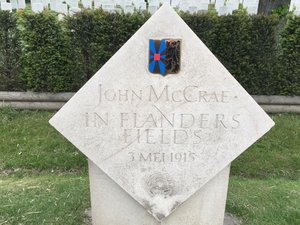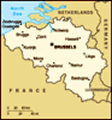Advertisement

 Essex Farm Cemetery
Essex Farm Cemetery
John McCrae worked as a field Doctor and it was here that he wrote his famous poem, “In Flanders Fields”It has been a busy three days as we drove from Paris to Belgium and then back to France to visit the World War 1 cemeteries and memorials. Ypres (pronounced e- pers) is about a 2 hours drive from Paris and we finally had some more seasonable weather, although there was still a chill in the air. Our 2 night stay in Ypres included the ceremony at the Menin Gate and a tour next day of some of the war memorials in the North Salient (Salient in this context is a military term for section). The guided tour included memorials/cemeteries at Essex Farm, St Julien, Langemark (a German Cemetery), Hill 62 and Passchendale, the largest Allied Cemetery of the war.
The Menin Gate Ceremony has been held every day since 1928 (except for the German Occupation of WW 11 when the ceremony was moved to England). Etched on the walls are the names of 54,896 commonwealth soldiers killed or missing in World War I in the Ypres Salient and have been unidentifiable. Under the Arch, crowds gather at 8:00 PM sharp to hear the ”Last Post” by 4 buglers and watch various groups lay wreaths under the arches.
Essex

 Canadian Monument at St. Julien
Canadian Monument at St. Julien
The title is “Brooding Soldier”Farm Is an area of the front line where John McCrae wrote his famous poem, “In Flanders Field”. He was stationed there as a Doctor and supposedly wrote the poem in response to a loss of two of his friends that he was unable to save. McCrae died of pneumonia in 2018 after serving at a number of locations during the war. (It’s amazing how historical facts can differ, our guide for the day said John McRae died of meningitis, but Wikipedia recorded his death of pnuemonia. It doesn’t really matter in this case but it makes you wonder how much historical information is factual)
There is quite a contrast between the German and Allied cemeteries. At Langemark, there are no upright grave markers, all are flat and they bury multiple soldiers together. There are only 3 Germany Cemeteries left in Belgium as over the years remains have been moved to larger facilities. At Langemark, a mass grave in the cemetary contains the remains of 24,000 Germain soldiers. Compared to the Allied sites, the German cemeteries are quite dark, although still well maintained.
St. Julien is the area where Canada installed a monument called the “Brooding Soldier”. It

 Canadian Memorial at Paschendaale
Canadian Memorial at Paschendaale
This was a new addition to the existing monument.is at an intersection called Vancouver corner(after asking numerous people and researching, I haven‘t been able to determine the reason for the name). There isn’t a cemetery here but it is the site where over 2,000 Canadians were killed in battle, many them exposed to the German’s use, for the first time, of poisonous chlorine gas. The park is extremely well done and contains a lot of vegetation native to Canada such as cedar bushes and maple trees
Our last stop of the day is the Tyne Cot Cemetery just outside of Passchendale. On the drive to the cemetery, there was a separate Canadian memorial but of a smaller scale than St. Julien. Passchendale was the site of a long battle to push the front line East and in which the Canadian soldiers finally succeeded after previous attempts by other allied forces. The cemetery itself is the largest Commonwealth cemetery in the world.
Vimy Ridge and the Newfoundland memorial were the last 2 stops the next day. The monument at Vimy Ridge is very impressive and although unveiled in 1936 it looks quite contemporary. It is an imposing structure that can be seen for miles on top of

 Tyne Cot Cemetery
Tyne Cot Cemetery
Over 12,000 soldiers from the Commonwealth buried here, many of them unidentified. the ridge. The monument is contained within a 250 acre Canadian National Park ( the land was given to Canada by France) that also includes an information center and 3 cemeteries. The Newfoundland memorial is smaller in size and about 40 Km from Vimy Ridge.
There is a mountain of information that we could include as a result of these tours, however, it’s probably best for those that are interested to do some research on line. You’ll be surprised about how Canada played such an important role in WW1 and of course the ultimate sacrifice thousands of our soldiers paid with their lives.
When travelling outside of Canada sometimes we feel a deeper sense of pride in our country than maybe we feel when at home. The last 3 days, after seeing all these Canadian memorials and cemeteries, was a “teary eyed” emotional experience. Certainly mixed emotions, a deeper sense of pride in the important role Canada played, but profound sadness in the human suffering and and the resulting carnage that thousands of Canadian soldiers experienced. What struck us about the Vimy Ridge monument in particular was how well it captured the essence of being a Canadian, a

 German Cemetery at Langemark, Ypres
German Cemetery at Langemark, Ypres
Quite a contrast to the Commonwealth Cemeteriescompassionate, peace loving people that mourns and remembers the loss of so many. There is certainly a big question as to whether all the suffering and loss in war was necessary? There had to be a better way to resolve conflict!
Advertisement
Tot: 0.415s; Tpl: 0.022s; cc: 11; qc: 48; dbt: 0.0943s; 1; m:domysql w:travelblog (10.17.0.13); sld: 1;
; mem: 1.2mb









